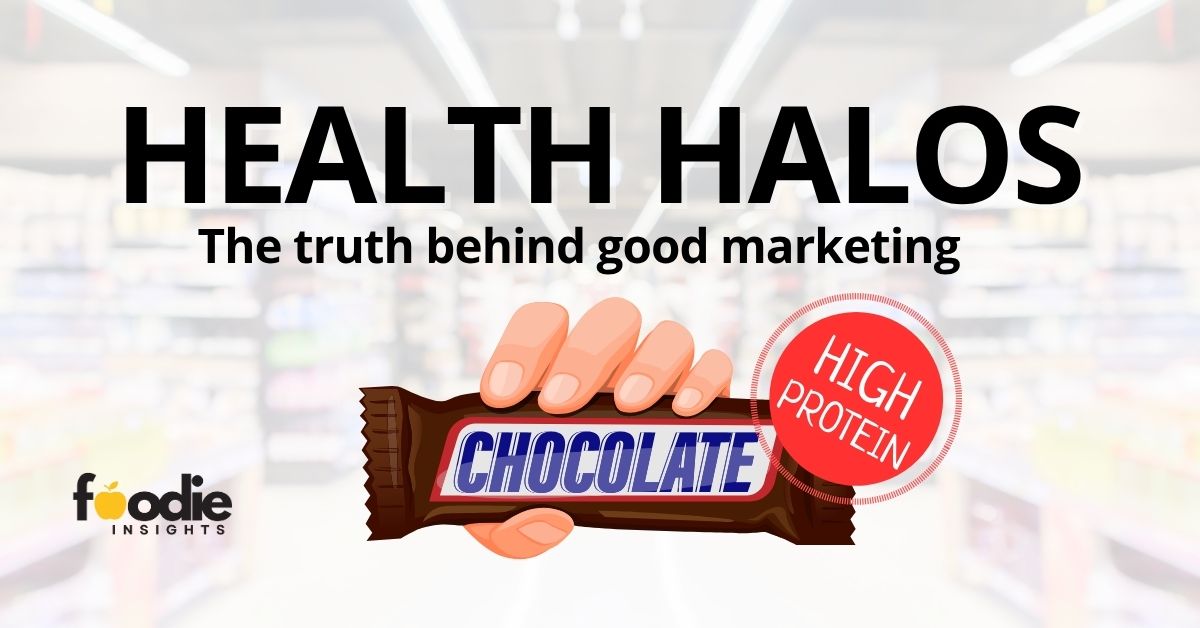Health Halo is a cognitive bias whereby one positive claim on a product influences its overall perception by consumers. One single claim like “organic” or “high protein” makes the product appear as healthier and more nourishing.
But is it actually as healthy as we think? Or is it just good marketing at work?
In this article, you’ll learn what health halos are and how to easily spot them. As a consumer, you’ll be able to make more informed purchase decisions. As a brand, you’ll understand what truly drives sales in the industry.
What’s the meaning of health halo?
Nowadays more and more people are growing conscious about their food choices. We’re eating more protein than ever, favor organic options and look for sustainability. The market for high protein products, for instance, is expected to reach over 100 USD billion by 2030 (Source: Gran View Research).
Brands are capitalizing on the latest trends to launch new product offerings that can appeal to consumers. While some are fortifying cereal with whey protein, others are replacing white sugar with sucralose or other artificial sweeteners.
The result? Protein-packed, sugar-free and similar claims are prominent on package labels. The goal is to influence consumer perceptions, so they instantly regard the item as more wholesome and nutritious.
This is the Health Halo effect at work. A positive attribute can create a domino effect, leading consumers to see the product as a healthy option.
Common marketing strategies
- Labelling – Front-of-package (FOP) labels are prime real estate for marketers. By combining claims like “high protein”, “organic”, or “natural”, even heavily processed foods can appear wholesome and nutritious at first glance. These cues simplify decision-making and make products seem healthier than they actually are.
- Colors – Color psychology plays a major role in shaping perceptions. Red and yellow tend to stimulate appetite and energy, which is why they dominate fast-food branding. In contrast, green, beige, and light brown tones are associated with health, nature, and wholesomeness, making packaged products appear more natural and less processed.
- Package material – The texture and finish of packaging also influence health perception. Shiny or glossy materials often feel artificial and “cheap,” while matte finishes, minimalist designs, and earthy textures are perceived as cleaner, more premium and healthier.
- Brand endorsements – Collaborations with athletes, nutrition experts, or fitness influencers are used to build trust and transfer their credibility onto the product. When consumers admire or relate to these figures, they subconsciously associate the product with the influencer’s healthy lifestyle and values.
- Brand name – A brand’s name and image strongly anchor consumer perception. Just as McDonald’s is linked with indulgence rather than health, a brand known for “natural” or “clean” products benefits from a positive halo across its entire portfolio. Once that perception is established, it shapes how every future product is judged.

What are the terms under health halo?
Added sugars and trans fat may be hiding behind products that, at first, seem good for you. Some of the most popular health halos are “high protein”, “vegan” or “plant based”, “natural”, “organic”, “sugar-free” and “gluten-free”. Oh, and let’s not forget “fat-free” and “keto”.
High protein
In the U.S., foods labeled “high in protein” must provide at least 20% of the Daily Value (10 g or more per serving), while in the E.U. the claim requires 20% of the energy to come from protein (Regulation EC No. 1924/2006). Despite meeting these thresholds, many “high protein” foods are still ultra-processed or high in additives, which can distort their perceived health value.
Vegan or plant-based
These terms mean the product contains no ingredients derived from animals, but they do not guarantee nutritional quality. Many “plant-based” snacks and desserts remain high in sugar, refined oils, or additives.
Natural
The FDA does not have a formal definition, but generally allows “natural” when no artificial or synthetic ingredients are added. In the E.U., “natural” is regulated more strictly for flavorings but remains loosely defined for foods, often giving consumers a misleading sense of wholesomeness.
Organic
In both the U.S. and E.U., organic foods must meet strict standards for farming and processing, avoiding most synthetic pesticides, fertilizers, and GMOs. However, the organic label does not guarantee lower calories, less sugar, or better nutrient density.
Sugar-free
A “sugar-free” claim means the product contains less than 0.5 g of sugar per serving, according to both FDA and E.U. rules. Yet many of these foods include sugar alcohols or artificial sweeteners, which can still influence cravings and taste perception.
Gluten-free
This label means the product contains less than 20 parts per million (ppm) of gluten, as defined by the FDA and E.U. Regulation (EC) No 41/2009. Gluten-free foods are essential for those with celiac disease but not automatically healthier for the general population.
Fat-free
To use this claim, a product must contain less than 0.5 g of fat per serving. Often, sugar or starches are added to replace texture and flavor, which can make fat-free foods more processed and less satiating.
Keto
There is no official regulatory definition in the U.S. or E.U., but “keto” typically means very low in carbohydrates and higher in fat. Many keto-labeled products rely on processed fat sources and sweeteners, creating a “low-carb” image that does not always match quality.

Real-life examples of the halo effect
We start our journey at the grocery store, where wholegrain cereal awaits. To our surprise, a long list of ingredients sticks at the back of its package: high fructose corn syrup and artificial flavorings can’t miss. Next, we hit the gym for a workout and grab a salted caramel protein bar. Just don’t think it has merely 12g of protein for over 250 calories and 10g of added sugars. We finish our trip at Subway, because you know, everyone says it’s the healthiest fast food!
With more consumers making healthier choices, health halos are behind every corner. Here are some examples, some of which may even be hiding in your kitchen!
Cinnamon Cheerios Protein
Cinnamon Cheerios Protein is marketed as a smarter, more nutritious alternative to regular cereal. With “8g of protein” and “12g of whole grains” per serving, gluten-free and natural, it sounds like the perfect family breakfast. They even contain oats!
But take a closer look at the ingredient list: over 25 ingredients, with sugar and low-quality oils among the first. The supposed 8g of protein are outnumbered by 12g of added sugar, turning this “healthy cereal” into a candy in disguise.
Protein Snickers
The original Snickers bar was never marketed as a healthy snack, until Mars introduced the “Protein Snickers”.
The label instantly makes it sound like a better choice. After all, high protein equals healthy, right? Not quite. Each bar still packs around 250 calories, delivers 35% of the daily limit for saturated fat, and includes both sugars and artificial sweeteners. The health halo works because “protein” distracts from what’s still a candy bar.
Plant based meat
With more people reducing meat consumption, plant-based burgers and sausages have exploded across supermarket shelves. Placed right next to traditional meat, they’re often sold at higher prices under claims like “vegan,” “guilt-free,” or “organic.”
But these claims don’t always match the nutrition facts. Many plant-based meats contain more saturated fat and calories than their animal-based counterparts, and sodium levels that can easily exceed recommended daily limits. “Plant-based” doesn’t always mean “healthy.”
Restaurant salads
Salads on restaurant menus are often perceived as light, low-calorie, and diet-friendly. A clever move that also makes the entire menu appear healthier, a phenomenon marketers call priming.
In reality, many of these salads carry more calories than a pasta dish. Dressings, cheeses, oils, and add-ons like bacon or fried chicken quickly push the fat and calorie count far beyond expectations.
Conclusion
Health halos show how easily perception can outweigh reality. A single claim, color, or label can make even the most processed foods appear like the healthier choice. For consumers, awareness is the first line of defense. Always read the ingredient list, not just the front of the package. For brands, credibility comes from transparency, not clever marketing. The most successful food products are those built on real nutritional value and honest communication.


